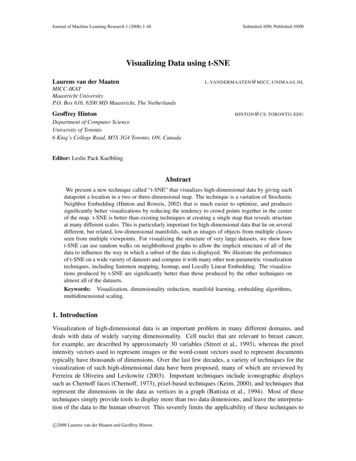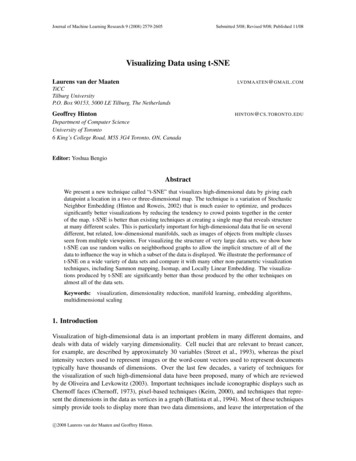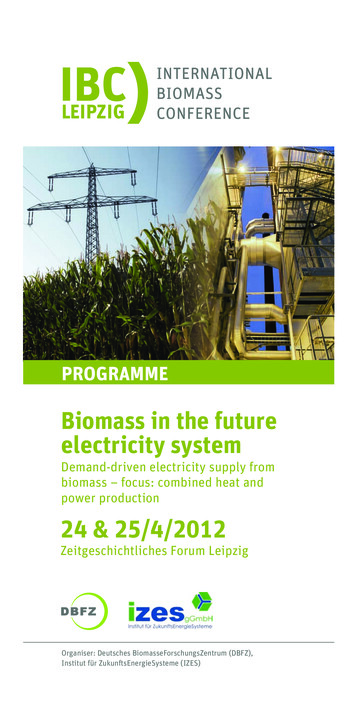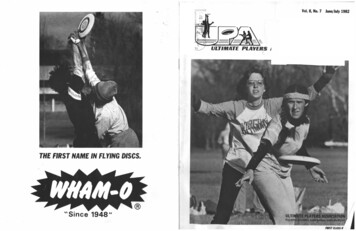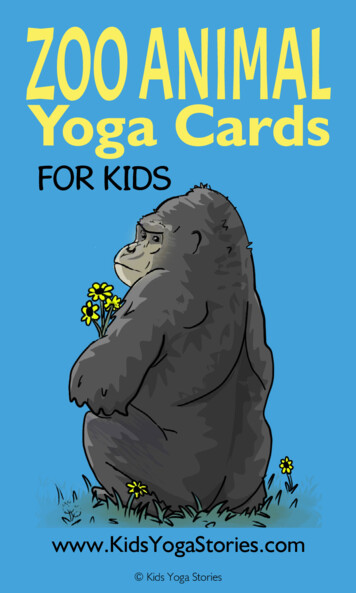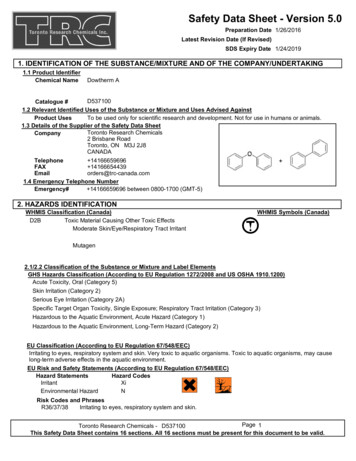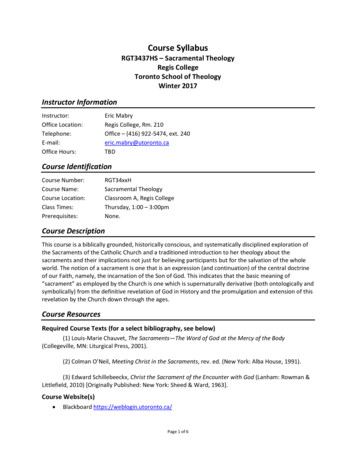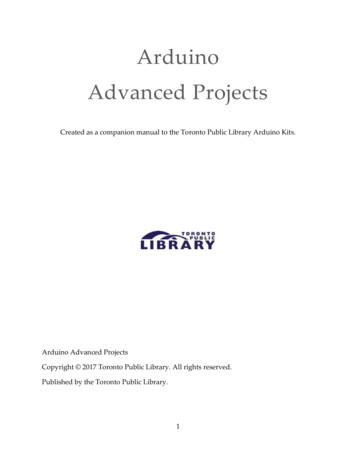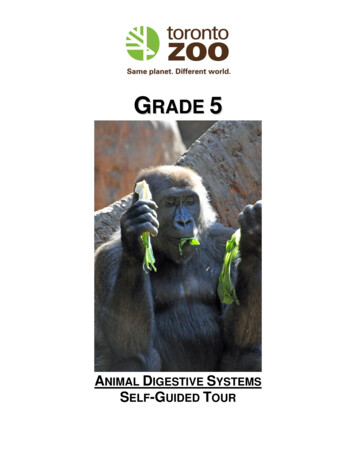
Transcription
GRADE 5ANIMAL DIGESTIVE SYSTEMSSELF-GUIDED TOUR
Contents Map (p. 3) Curriculum Objectives (p. 4) Introduction (p.4) – The human digestive system; the digestive process inhumans; animal digestion; teeth Tour (p. 6) Indian Rhinoceros Pavilion (p. 6) – Indian rhinoceros, Malayan tapir Malayan Woods Pavilion (p. 7) – Butterflies, red-tailed green ratsnake Indomalaya Pavilion (p. 8) – Jumbo gourami, fish tank, gaur, reticulatedpython, orangutan, crocodile newt African Rainforest Pavilion (p. 10) – Western lowland gorilla, West Africandwarf crocodile, African bonytongue, sacred ibis Conclusion (p. 12) – Conclusion2
Site Map Stops on your tourAfrican vilionIndianRhinocerosPavilion3
Grade 5 Curriculum Objective:Demonstrate an understanding of the structure and function of the digestive system andthe organs within the system.INTRODUCTIONThe following discussion outlines suggested topics for review prior to visit.The human digestive system Before we discuss how we process our food, we’ll begin with an important question:why do we eat? Eating food allows us to get energy for our bodies to work, andnutrients to allow us to grow. When we eat, our body must break down our food into smaller molecules so that itmay be used. This is the process of digestion. We have a special organ system used to break down food. What is it called? Thedigestive system. Two types of digestion occur when we eat. The first is called mechanical digestion.This is the process of breaking down food into smaller pieces, like when we chew. The second type of digestion is chemical digestion, which occurs when enzymesbreak down food to retrieve nutrients that can be broken down into smallermolecules and used by the body.The digestive process in humansMouth The first step begins while food isstill inside our mouths. We take infood, and begin to break it down bychewing it. Our saliva helps to begin the breakdown of food by softening it so wecan swallow easily. Food that hasbeen softened by saliva is called abolus.Oesophagus When we swallow, food travelsdown the tube-like oesophagus.The oesophagus is a very strongmuscle that makes wave-likemovements, pushing fooddownward. The oesophagus is sostrong that it would allow you toswallow even if you were standingon your head! (But of course, we wouldn’t suggest trying this!)4
Stomach Once the food enters the stomach, it is churned and broken down by gastric juices.These juices are acidic and turn the food into a pasty substance called chyme. Foodcan stay in the stomach for several hours at a time. Humans are monogastric which means that we have only one stomach.Small Intestine In the small intestine, food is further broken down so that it may be absorbed into thebloodstream. The nutrients absorbed by the body provide energy and allow growth.Large Intestine Any left over food which has not yet been digested goes through the large intestine.Salts, minerals, water, and vitamins are absorbed through this organ.Rectum / Anus The final stop is the rectum and anus. Any waste that our bodies don’t use isexcreted through the anus.Animal Digestion Do animals digest their food the same way we do? Not always. The digestivesystems of different animals change depending on what they eat. Some herbivores, like rhinos, elephants, and zebras, are monogastric like people.As we learned before, this means that they have only one stomach. Like us, these animals use their mouth, oesophagus, stomach, and intestines muchthe way we do, but they have an added feature – the cecum. After passing throughthe intestines, food is further digested by specialized micro-organisms and bacteria.These live inside the cecum and release nutrients by eating plant material. Other herbivores, called ruminants, have more than one stomach. Their digestivesystems are useful as plants are difficult to digest. Cell walls of plants consist ofcellulose which cannot be digested by humans. Ruminants, however, are able todigest cellulose with the help of special micro-organisms living in their stomachs. While herbivores have a relatively long digestive process to break down tough foods,carnivores break down food much faster. Birds have very different digestive processes from other animals. Their beak andtongue allows them to pick up and move food for swallowing. The oesophagus islarge, allowing birds to swallow food whole since they do not chew. Many birds have a crop. The crop holds food so that the bird can eat very quickly,and fly away to digest somewhere safe. Like our saliva, the crop moistens food toprepare it for digestion. Instead of a stomach, birds have a gizzard used for mechanical digestion. Pebblesand sand in the gizzard help to grind up the food. Any materials that cannot bedigested, such as bones and fur, are caught by the gizzard and formed into a pelletto be regurgitated. These are just some examples of the many different ways animals digest their food.As we tour through the Zoo, we will learn more about how animals process theirfood.5
Teeth We know that teeth are important in the process of mechanical digestion. Why doesthe shape of an animal’s teeth matter? What might a carnivore’s teeth look like? Animals that eat meat often have verysharp teeth. This is important as it helps them bite through skin and flesh. Herbivores often have pointed teeth at the front of their mouths to help them snipvegetation to eat. The back of their mouths holds flatter molars for grinding up plantmatter. Knowing what carnivore and herbivore teeth look like, how do you think omnivoreteeth would look? Since omnivores eat both plants and animals, they have both flatmolars and sharp teeth for biting. What do our teeth look like? Our teeth are those of an omnivore.TOURIndian Rhinoceros PavilionIndian rhinoceros The rhino is a monogastric herbivore. Thismeans that it is a plant-eater with only onestomach. These animals eat grasses, leaves,and branches. Rhinos are called browsers meaning that theywill lift their heads to eat shrubs and smalltrees. You may have heard of the term grazerwhich is similar. Grazers are animals like cattlewhich feed on grass. We have learned that the process of digestionbegins with the mouth. How do you think thisanimal gets food into its mouth? Rhinos usetheir prehensile lips almost like we would use our hands to grasp and hold things. These animals have flat molars which are perfect for grinding down food. We know that the rhino is monogastric, and we learned earlier about the specialadded feature some herbivores have to aid digestion. What is this organ called? Thececum contains micro-organisms like bacteria and protozoa which break downcellulose. The colon also aids in this. This process is called hindgut fermentation. At the Zoo, the rhinos eat hay, barley, some fruit, and a prepared herbivore ration.Malayan tapir Like the rhino, the tapir is also a monogastricherbivore. Tapirs use their snout to forage for food. Ituses its senses of smell and touch to search6
through vegetation. Hairs at the tip of the snout allow it to feel around.Once food is located, the snout can fold out of the way so that the tapir can grasp itwith its teeth.Also like the rhino, tapirs have special bacteria in their cecum to break downcellulose.At the Zoo, the tapir eats alfalfa hay, herbivore cubes, apples, lettuce and carrots.Malayan Woods PavilionRed-tailed green ratsnakeButterflies (throughout pavilion) Butterflies’ mouths are different from our own. Butterflies have a long appendage,somewhat like a straw, called a proboscis. The proboscis allows the butterfly to drinkjuices. While most butterflies drink nectar from flowers, some actually drink tears! Thesebutterflies sweep their proboscises over the eyes of grazing animals to cause theireyes to tear. The butterflies can then drink the fluid. At the Zoo, the butterflies’ main diet consists of fruit like oranges.Red-tailed green ratsnake This animal is a monogastric carnivore. What does this mean? It means that thesnake is a meat-eater with one stomach. Snakes swallow their food whole. What do you think this animal eats? This snake eats small mammals like mice, andother small animals like birds or lizards. This species may constrict around the preyto kill it, and secure it while it grabs a hold ofthe animal using its mouth. The snake’s jaws disarticulate while it eatsits prey. This means that specialized jointsopen up to allow the jaw to become wider(note: contrary to popular belief, snakes donot “dislocate” their jaws; no unhingingoccurs).7
Snakes do not chew their food, but rather swallow everything whole. They “walk”their jaw along the prey’s body, moving alternating sides forward until the last of theitem enters the mouth.Do you think snakes have an oesophagus? Much like in people, the snake’soesophagus pushes food into the body using wave-like motions. These movementsare called peristalsis.The snake has strong stomach acids to dissolve bones. Sometimes, the fur remainsand can be seen in the feces.As we learned before, carnivores have much shorter digestive systems thanherbivores. Snakes cannot process plant matter at all; it passes through the bodyuntouched.It takes days or even weeks for the snake to digest. Body temperature determineshow fast the process occurs.Reptiles such as snakes, as well as birds and amphibians, do not have an anus.Once the waste is ready to be excreted, it passes through an opening called thecloaca. The cloaca is the point of exit for both the intestinal and urinary tract (note:both marsupials and monotremes, although mammals, have cloacas).Indomalaya PavilionCrocodile newtSumatran orangutanReticulated pythonGaurHouseJumbo gouramiFish tankJumbo gourami These fish are omnivores. What does this mean?Gouramis eat both plant and animal matter. Foodsinclude aquatic weeds, fish, frogs, and worms.The mouth is near the top of the head as food isretrieved from the surface of the water. The location8
of the mouth is also important as gouramis are air breathers.Seeds of eaten vegetation pass through the gourami’s system. Gouramis are seeddispersers, meaning that as they defecate, the seeds are passed on to grow intonew vegetation.Fish tank Fish have similar digestive systems to other animals. As we have seen, food entersthe mouth, passes through the oesophagus to the stomach, and through theintestines. Also like other animals, fish that are herbivores have longer digestive systems thando meat-eating fish. Fish have very different teeth depending on their main food sources. For example,some fish have long and sharp teeth to grasp and keep control of prey, or even tearflesh apart. Other fish that eat small matter have bristle-like teeth for sweepingdebris out of the water.Gaur The gaur is a ruminant. What does this mean? As we learned, ruminants areanimals with more than one stomach. Gaurs have four chambers. The rumen is the first stomach. Bacteria assist in turning the plant matter into apulpy substance. After the rumen, food moves through the reticulum. The reticulum forms food into acud to be regurgitated. The gaurs then re-chew the food. Once the gaur has again swallowed the food, it passes to the omasum. This organacts in much the same way that the saliva in our mouth does to further break downthe food. Finally comes the abomasum, or the “true stomach”. It is the last stomach andprepares the food so that the intestines may absorb the nutrients. At the Zoo, gaurs are fed herbivore cubes, timothy hay, and beet-pulp blocks.Reticulated python We learned about snake digestion earlier when we sawthe red-tailed green ratsnake. What kind of digestivesystem do these carnivores have? Snakes aremonogastric. Would you believe that this snake can open its mouth wideenough to eat a goat? It’s true! Through disarticulation,snakes are able to open wide and stretch out the elasticconnective tissue on their mandible (lower jaw). Similar to the red-tailed green ratsnake, the python “walks”its jaw along the prey to devour it. Specialized backwardfacing teeth help to ensure that the prey is secure in themouth.Just like we do, snakes need to be able to breathe while they eat, but with such ahuge mouthful, how is breathing possible? While eating, a special tube is exposed inthe snake’s mouth which allows for air exchange.9
Sumatran orangutan Orangutans are omnivores meaning that they eat both plantand animal matter. They enjoy fruit, leaves, nuts, shoots,insects, and sometimes birds and small mammals. The digestive system of an orangutan is more similar to that ofa carnivore than an herbivore. This means that these animalsconsume high quantities of food daily as their digestivesystems are rather inefficient at processing plant matter. At the Zoo the orangutans eat a gelatine diet as well as freshfruits and vegetables.Crocodile newt Like snakes, this animal is a monogastric carnivore. A newt’s diet in the wild would consist mainly of insects, so these animals are a typeof insectivore. At the Zoo, the newts are fed pinkie mice and beef heart gelatine.African Rainforest PavilionSacred ibisAfrican bonytongueWest Africandwarf crocodileGorilla rainforest exhibitWestern lowland gorilla Gorillas are herbivores with only one stomach. We learned that herbivores have a longer digestive system thancarnivores. Gorillas are one example. They have long intestines,and eat lots of food which stays in the body for a long time. This iscalled residence time, and the longer journey of the food through10
the intestines allows for more nutrients to be extracted than otherwise would be.Gorillas spend much of their day eating, and consume various plant mattersincluding fruit, shoots, flowers, leaves, and more.While gorillas have large canine teeth, they also have molars suited for breakingdown plant material.West African dwarf crocodile Is this animal an omnivore, carnivore, or herbivore?Again similar to snakes, this animal is amonogastric carnivore. The crocodile will eat small animals like fish andamphibians, and also carrion (dead animals). Sharp teeth and extremely powerful jaws help thecrocodile grab onto prey. Gastroliths or “gizzard stones” are small pebbles orstones that stay inside the digestive tract of crocodiles and some other animals, andgrind food down, much like teeth would.African bonytongue This fish is known as a filter-feeder. Eventhough it looks big, bonytongues actually eattiny little particles of food like zooplanktonand algae. To retrieve food from the water, thebonytongue has a special organ thatsecretes mucus over a spiral shaped filter(over part of the gill arch). This mucus trapsparticles to be drawn into the mouth. These fish are monogastric omnivores.Sacred ibis These birds are monogastric carnivores, eating small animals like fish, frogs, andinsects. Their curved beaks allow them to pick up prey from water and sift through mud. These are an example of a bird with a crop. This organ provides storage for fooduntil the bird reaches a safe place and is able to digest. We learned that the gizzard of birds often contains gastroliths to aid in mechanicaldigestion. These are present in the ibis.11
CONCLUSIONSample Discussion Questions What are some examples of monogastric herbivores and ruminants that we sawtoday? The Indian rhinoceros and Malayan tapir are examples of monogastricherbivores. They digest plant materials through hindgut fermentation. The Gaur is a ruminant and possesses four stomachs to aid in its digestion. What is a difference between the digestive system of a monogastric herbivore and amonogastric carnivore? What are examples of each of these that we saw today? Monogastric herbivores have long intestines and eat lots of food which can stayin the body for a long time. This allows for more nutrients to be extracted thanotherwise would be. Examples include Indian rhinoceros, Malayan tapir, andWestern lowland gorilla. Monogastric carnivores have shorter intestines than herbivores and are unable tofully digest plant material. However, animal material is digested quite quickly.Examples include Red-tailed green ratsnake, Reticulated python, Crocodile newt,West African dwarf crocodile, and Sacred ibis. We know the gaur is a ruminant because it has four stomachs, what animals foundon a farm do you think are also defined as ruminants? Animals found on a farm that are defined as ruminants include cattle, sheep, andgoats. (Note: Some students may suggest horses, however horses performhindgut fermentation similar to the rhino and tapir, therefore they are notruminants!) What is the main difference between the teeth of carnivores and herbivores? Carnivore teeth are sharp and used for tearing flesh, whereas herbivores havepointed teeth at the front of their mouths to help them snip vegetation to eat andflat molars at the back of their mouth which are used for grinding up the plantmaterial. Thinking about your own teeth, would you consider yourself a carnivore, herbivore oromnivore? Humans possess both sharp teeth for tearing and flat teeth for grinding, we areconsidered omnivores.12
Indian Rhinoceros Pavilion Indian rhinoceros The rhino is a monogastric herbivore. This means that it is a plant-eater with only one stomach. These animals eat grasses, leaves, and branches. Rhinos are called browsers meaning that they will lift their heads to eat shrubs and small trees
